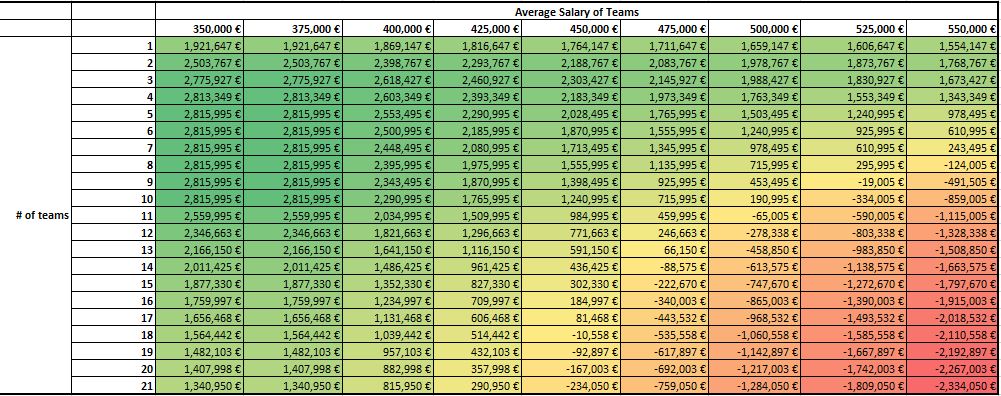Ok, very nice progression approach, but before I come to that, I need to clarify some things:
team fl wrote: ↑Thu Jun 13, 2019 9:35 am
At the moment, theoretically, a 10 team race is the most profitable.
I wish! Unfortunately, this is not correct, and I am stepping up to make everyone aware of that. Most players are "feeling" it already correctly on their finances, that somehow it seems easier to earn money in smaller races and it is true. You can see that if you look at my file. But let me also illustrate it for you with a heat map. This is the relation between # of teams, average salary and average profit today. (
green = high profit,
yellow = 0,
red = high loss) I took the Giro as an example, but this is true irrespective of the race category and number of days. Only the amounts will adjust, but the colors will stay the same.

- HeatMap1.JPG (150.66 KiB) Viewed 19050 times
You can see, that a 10 team race is never the most profitable alone. If nobody has an uncovered salary, 4-10 teams is optimal. But as soon as somebody pays a higher salary than the starting premium, a 3 team race is the most profitable! I call this the 2-for-1 advantage. You get 2 advantages (easier to get good placements, lower salary) for 1 disadvantage (lower prize money). It would be better to have a 1-for-1 advantage. You get only one advantage (easier to get good placements) for 1 disadvantage (lower prize money). The heat map would like this then:

- HeatMap2.JPG (141.74 KiB) Viewed 19050 times
I will put the heat maps also in the Excel File for you to play around and test it. But this really brings me to another important point to be clarified:
team fl wrote: ↑Thu Jun 13, 2019 9:35 am
But I fear if we just increase the money for bigger fields, there will just be more money in the system, but there will not be a more "fair" distribution. And with more money in the system, riders will get more expensive most likely, as teams have more money to spend.
My proposed change will, if anything, actually lead to the opposite, most likely! It will reduce the money in the system! Why is that? Well, today our races mostly take place in the "upper half" of the chart: Few teams, High Profit. If now, we adjust it to my proposal, the upper half of the chart will be only as profitable as the lower part. Basically, this is an automatic adjustment for money in the system. Because even if number of teams increases or decreases, the profit per team will remain the same! So with a more balanced capital in the system, riders will not get more expensive. The whole auction system will just be more balanced.
OK, but now let me come to your progression approach:
team fl wrote: ↑Thu Jun 13, 2019 9:35 am
- In a very small field, even if you win the race and have additional placements due to the little amount of riders in the race, you may get less money than winning in a 10 team field and having no other money relevant placement.
- In a very big field, let's say 21 teams, at least one team will not be in the top 20 and hence not earn much money anyway.
In my point of view, these two features represent a "fair" compensation. A win in a 10 team field should be worth more than a win a very small field, shouldn't it? Because in fact, the "additional placements" in a very small field are very easy to obtain und it is not useful to incentivize players to ride for, let's say, the 7th place in a 3 team race.... Then, regarding the 21st place in a 21 team race: Even if there are 21 teams, the 21st place shouldn't be worth much, should it?
So from there, I am not sure why it would be useful to introduce a progression approach. If there is a good reason for progression, and if average profit per team is unaffected, I would of course discuss that. Because I believe, my approach and Progression do not oppose each other, they could be combined. But I think I first need to understand why you would really prefer the progression. Also because I am afraid, progression would be even more difficult to implement than what I suggested so far .
My fellow cyclingfreaks: ask not what the game can do for you - ask what you can do for the game.